It’s always a thrill to see a new bird, and it’s an even bigger thrill to take photos of a new species. To get high-quality photographs of that species, it takes a lot of luck, and some technical skills, but it especially takes good timing. That was the case when I encountered and photographed a pair of American Oystercatchers last Wednesday on a small Florida island, Mullet Key, located on the southwest side of Tampa Bay. Walking a short distance inland from the white sand beach, as I approached the edge of a shallow lagoon the sight of a pair of American Oystercatchers immediately caught my attention.
Aside from all the shorebirds and wading birds and any other species I would encounter, American Oystercatchers were the birds I most hoped to find and photograph here – and there they were. These impressive birds represented a species I have never had an opportunity to photograph before, and I have really only seen them a precious few times; so I lingered a good 40 minutes with the oystercatchers, large and bulky for shorebirds, with striking coloration – white below with a brown back, and black neck and head, accented with a long, broad, bright red beak and ornate orange eyes with black pupils circled by red eyelids – stunning birds.
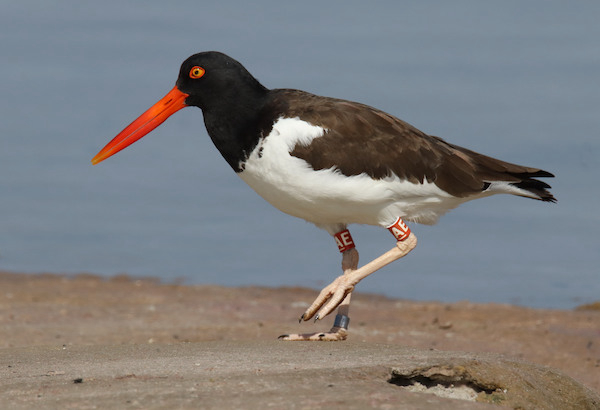
Timing
At first, one oystercatcher was foraging the shallows of the south end of the lagoon, probing here and there as it made slow progress before me. The second bird was lying on the sand, resting adjacent to the lagoon. I photographed both birds, then focused on the more active one, appreciating the remarkable morning light that provided bright accurate colors, without being too harsh, highlighting the birds, the water, and the sand perfectly. The beautiful lighting can be attributed to the angle of the sunlight during the mid-morning hours of this winter day, the first of February. I positioned myself so I was standing with the sun at my back and the birds in front of me, and my shadow pointed at the birds as a reminder that I was positioned correctly.
That’s where the importance of timing comes into play. First, choose a sunny day to photograph – watch the weather report, and make the most of a sunny morning or afternoon. During winter, the angle of the sun is surprisingly good throughout much of the day. I try to avoid photographing during midday when the sun is highest in the sky, but I found that even then, the photos I take show impressive lighting quality. (That changes with the midday positioning of the sun during spring and summer, when the sunlight comes from overhead rather than at a lower angle.)
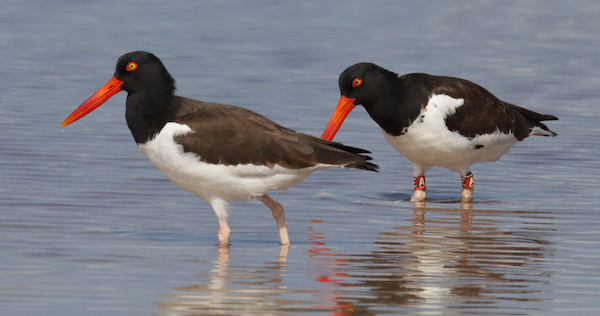
As for the presence of the birds and their trusting nature, there is a big level of luck involved. First, luck that the oystercatchers were even there. I was lucky indeed! When I returned a few days later, there were no oystercatchers, none of the other shorebirds I encountered that first day, and no wading birds – what a surprise! But it strongly underlined the aspect of luck in birding – timing and luck are so important for successful bird photography.
Bird behavior tends to be ever-changing, day to day, month to month, hourly, and sometimes by the minute. We always need to take advantage of finding birds in good photo situations, and rather than taking a photo or 2 and moving on; spending some time in the birds’ company when that doesn’t impair what they are doing. The birds I encountered throughout the Tampa area were immersed in the expanse of human habitations, and their trust is built on the positive interactions they have with people day by day, which worked in favor of this photographer and others I crossed paths with periodically that morning.
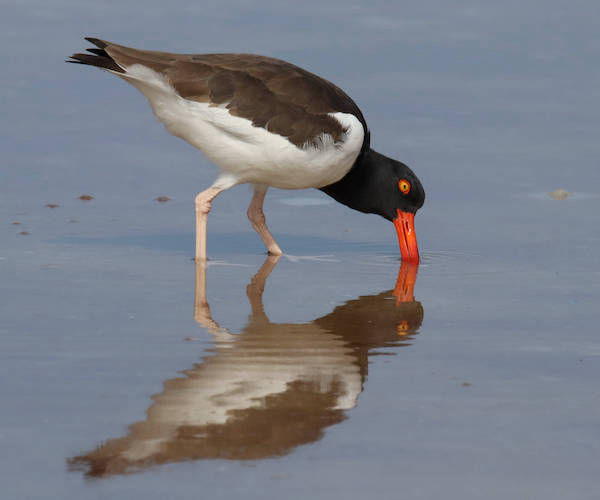
Yes, there are wary birds, some that take flight at the arrival of a person who doesn’t keep moving – who stands or kneels or sits holding a camera with a big glass lens pointing at them. But that underlines staying in my vehicle to photograph from its cover if that suits them better, and if I can park in an appropriate location. It all works out; some birds permit you to photograph them and others don’t. I just try not to worry them or change their activities by getting too close or moving in a way that they react to – and the birds of Florida certainly have been accommodating.
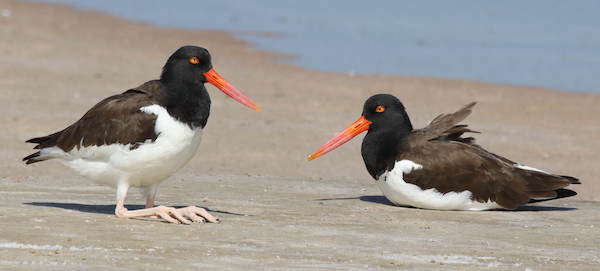
Oystercatcher Insights
Eventually, the foraging oystercatcher walked over to join the resting bird, presumably its mate. That bird was banded with color-coded plastic bands that had the letters AE printed in white against the red band colors. These bands permit biologists to learn more about that individual bird’s movements and other information when they see the bird, or when birders and other people report seeing the banded birds, providing location information with color and letter or number details. The resting bird was not banded, which provided a bit of variation among the photos I took, while also permitting me to tell the 2 birds apart easier.
The oystercatchers rested for a bit, facing one another, and I wondered if that was perhaps my cue to move on to photograph other birds. But before I made a decision about whether to go or stay, the unbanded oystercatcher stood up, preened a bit, and entered the water’s edge to begin foraging. Great, now I could continue photographing its progress, and soon the banded bird resumed its wading food search too.
Aside from their foraging activities, which simply included their visual search while wading slowly through shallow water, probing occasionally for a mollusk with their large red bill, and prying them open to extract the food, the oystercatchers didn’t provide many options for action photos. But just to be in the presence of such impressive birds, sharing their calm demeanor, appreciating their tranquil setting of windless water shallows, was a one-time opportunity that I appreciated from start to finish. The pair provided some of my favorite photos during my visit to Florida – as well as favorites for the new year, and for that matter – during the ’20s decade. These were impressive birds that I haven’t spent time with before that added so much to my Tampa experiences.
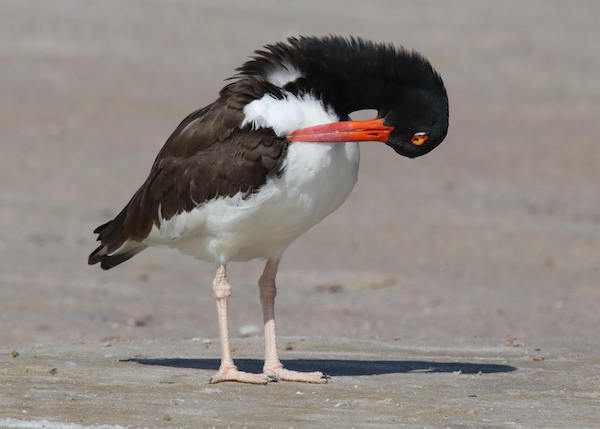
Tech Settings
With the sunlight providing perfect mid-morning lighting during the oystercatcher photo session, I used my usual camera settings, starting with the Av (aperture priority) setting on the Mode Dial of my Canon camera. I had my aperture (f-stop) set to f-10 to provide plenty of area in focus around the oystercatchers, and the camera automatically provided the associated shutter speed as determined by the amount of available light. While photographing, the shutter speed varied from 1/1250 of a second to 1/2500, which provided sharp, clear images of the birds.
The ISO setting also plays into the lighting scheme, and with full sunlight available I use a setting of ISO 400 as my standard. A zoom lens can be helpful when positioning a bird in the photo frame while initially taking a photograph. Using my 150-to-600mm Tamron zoom lens, I usually pulled back to a 550mm magnification, and as low as 420mm for some photos.
If you are interested in reading more about that particular morning of birding and the range of exciting birds I enjoyed photographing, you can refer to my Editor Afield article in this issue, which describes my full morning of avian interactions. During my stay in Florida I’m enjoying many more birding activities, and I’ve photographed a host of other birds, which I will share with you in coming issues. For now, enjoy these days of February, in your yard, in your neighborhood, and wherever you venture in search of birding adventures – Enjoy the birds around you.
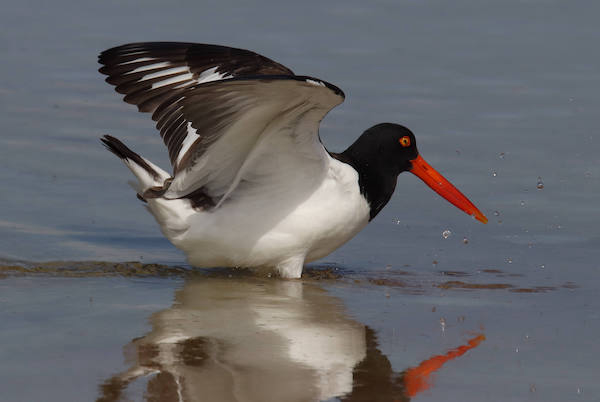
Article and photographs by Paul Konrad
Share your bird photos and birding experiences at editorstbw2@gmail.com